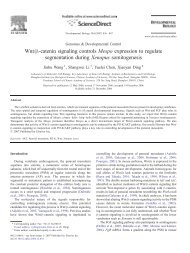<strong>Nucleic</strong> <strong>Acids</strong> <strong>Research</strong>, 2005, Vol. 33, No. 11 3609Figure 2. Predicated T-stem secondary structures of WT hmtRNA Leu (CUN) and the designed variants. Numbering of the nucleotides is according to Sprinzl et al.(39). (A) Two alternative T-stem alignments in WT hmtRNA Leu (CUN) transcript. U48 at the variable loop of Ta alignment slips to T-stem and forms a new U48:A65base pair in Tb alignment with 8 nt T-loop; (B) various hmtRNA Leu (CUN) constructs with designed T-stem. The U48N (N = A, G, C), G52A/C62U and U51A/A63Umutants were dominated in the Ta alignment; the U51G mutation was dominated in the Tb alignment; the D48 and U48C/+G54 mutants were designed to mimic theeffect of T-stem slip on V-loop and T-loop, respectively.of the WT and U48C mutant are summarized in Figure 3B.It appears that the fragment indicated with a pentacle inFigure 3B was due to the U48 shift in the T-stem.Manipulation of the T-stem slip of hmtRNA Leu (CUN)To investigate the effect of the different T-stem basepair alignments on the structure and aminoacylationof hmtRNA Leu (CUN), we constructed mutants ofhmtRNA Leu (CUN) that would stabilize in either the Ta orTb alignment depending on the T-stem structure (Figure 2B).Similar to U48C mutant, U48A and U48G mutants were createdto restrain the T-stem slip by prohibiting the base pairingbetween 48 and 65 residues. These two mutants would theoreticallystabilize in the Ta alignment. Two double mutations,U51A/A63U and G52A/C62U, were designed to preventthe T-stem from slipping by introducing an inside bolt inthe T-stem. In the U51A/A63U mutant, the U50A63 basepair became unpaired U50U63 so that the Tb alignment of theT-stem was unfavorable and the Ta alignment dominated.Similarly, in G52A/C62U mutant the unpaired U51U62was unstable, favoring the Ta alignment of T-stem. Anothermutant, U51G, was constructed to facilitate a T-stem slipby forming a base pair between G51 and C62, thus favoringa Tb alignment. In the U51G mutant, the T-stem slip reducedthe size of the variable loop 1 nt (from 4 to 3) and enlarged theT-loop by 1 nt (from 7 to 8) relatively. To ascertain the effectof the alteration on aminoacylation of hmtRNA Leu (CUN),mutants were constructed with a 3 nt variable loop or 8 ntT-loop. The D48 mutant had a deleted nucleotide at position48 to test the effect of a reduced variable loop and theU48C/+G54 mutant contained 8 nt in its T-loop.The design for each tRNA variant was confirmed bysecondary structure prediction (data not shown). Enzymaticprobing was further performed with the representative tRNAtranscripts. Although the digestion signal at the T-loop wasweak, probably due to the tertiary structure protection, theexpected alignment patterns were still detectable. As presentedin Figure 4A, no dose-dependent RNase T1 cleavage site atG53 was detected in either the U51A/A63U or the D48 mutant,which indicated that the T-stem slip was restrained by thesemutations. Meanwhile in the U51G and U48C/+G54 mutants,RNase T1 cleaved at G53 and G54, respectively, which wasconsistent with the T-loop enlargement. Moreover, some othercharacteristic differences in the structures of tRNA variantswere detected. For example, the nucleotides in the T-stemwere cleaved by RNase V1 in the 7 nt T-loop variant (D48,U48C and U51A/A63U), whereas T-stem cleavages did notoccur in either of the mutants with an enlarged T-loop (U51Gand U48C/+G54). Moreover, G10 and G11 in the D-stems ofboth the U51G and U48C/+G54 mutants were cleaved byRNase T1, suggesting that the T-loop enlargements inducedchanges in their D-loops. These differences most likely reflectdomain–domain interactions between the D- and T-loops in
3610 <strong>Nucleic</strong> <strong>Acids</strong> <strong>Research</strong>, 2005, Vol. 33, No. 11these mutants are shown in Figure 5 and the kinetic parametersare presented in Table 1. The aminoacylation of the threeU48N (N = A, G, C) mutants increased similarly comparedwith the WT transcript. The results indicate that the increasedaccepting activity of the U48C mutation is due to the secondarystructure rather than a specific residue substitution.The two T-stem double mutants showed greater increases(2.91-fold for U51A/A63U and 2.13-fold for G52A/C62Uas compared with that for WT transcript) in charging efficiency(k cat /K M ) than those of U48 mutants, suggesting that thestability of Ta alignment and instability of Tb alignment isvery important for the accepting activity. The D48 mutant,which mimicked the shortened variable loop resulting froma T-stem slip, also presented increased plateau level (65%)and charging efficiency (1.61-fold increase relative to WT).It is possible that the shortened variable loop inhibitedT-stem slip, favoring the Ta alignment. Conversely, theU51G mutation that promoted the T-stem slip, favoring theTb alignment, dramatically decreased the charging activityof hmtRNA Leu (CUN). Less than 0.5% of the U51G mutantwas aminoacylated following a 40 min incubation under theexperimental conditions. The U48C/+G54 mutation with the8 nt T-loop, which mimicked the T-loop induced by a T-stemslip, also showed decreased aminoacylation. Neither of thesetwo mutants displayed sufficient aminoacylation to determinethe kinetic parameters. This result suggests that the size ofthe T-loop is critical for the tRNA charging activity in thatcharging capacity is decreased by the addition of bases intothe T-loop, even when T-stem is unchanged. The data suggestthat the negative effect of a T-stem slip on aminoacylation ofhmtRNA Leu (CUN) is due to the increased size of the T-loopinduced by the slip.Figure 3. Comparative enzymatic probing of in vitro transcribed humanmitochondrial tRNA Leu (CUN) and the U48C mutant. (A) Autoradiogramsof the various cleavage products of 5 0 -end-labeled tRNA transcripts separatedon denaturing 12% polyacrylamide gels. Lane C, control incubations withoutprobe; lane L, alkaline ladder; lane G, G ladder. The tRNA was 5 0 -labeledand digested with RNase T1, RNase V1 and nuclease S1. Numbers 1 and 2 referto increasing concentrations of nuclease. The RNase T1 cleavage productspecific for WT transcript was indicated in the solid-line square. The differencecan be easily seen in the dashed-line squares. (B) Result of the enzymaticprobing of WT and U48C mutant hmtRNA Leu (CUN) transcripts. Intensitiesof cuts are proportional to the darkness of the symbols. The pentacle denotesthe specific RNase T1 cleavage at G53 on WT transcript.hmtRNA Leu (CUN). The patterns of enzymatic digestion ofeach tRNA mutant are given in Figure 4B.The charging efficiency of hmLeuRS for each designedtRNA variant was examined. The accepting activities ofDISCUSSIONComparison of the variable loops and T-stems of E.coli (21),Aquifex aeolicus (22) and human cytoplasmic (23) tRNA Leu swith those of hmtRNA Leu (CUN) indicates that there are severalfeatures that determine whether a tRNA Leu s structure isconducive to a T-stem slip. All 5 bp in the T-stem of E.colitRNA Leu (CUG) and A.aeolicus tRNA Leu (CUC) and the 4 bp inthe T-stem of E.coli tRNA Leu (CUC) and human cytoplasmictRNA Leu (CUU) are GC pairs. This high level of GC basepairing in the T-stem stabilizes the Ta alignment and therebyinhibits a T-stem slip in the above tRNA Leu s. A T-stem slip isfurther disabled by the inability of the base at position 48 inthe variable loop to form a base pair with the base at position65 in these tRNA Leu s. Finally, the large size of the variableloops in these Ta stable tRNA Leu s (12–16 nt and 2–4 bp) is ahindrance to a T-stem slip. In contrast, because only 2 of the5 bp of the T-stem are GC pairs in hmtRNA Leu (CUN), the Tastructure configuration is less stable than that in the abovetRNAs. Moreover, in hmtRNA Leu (CUN) U48 exactly pairswith A65 following a T-stem slip, and the variable loop issmaller containing only 4 nt and no base pair. These uniquestructural features of hmtRNA Leu (CUN) enable a T-stem slip.The inherently fragile structure of hmtRNA has been discussedpreviously (24–26). In this work, the structural fragilityof hmtRNA Leu (CUN) is specified as a mechanism of T-stemslip. The T-stem slip can result in a mixture of Ta and Tb







